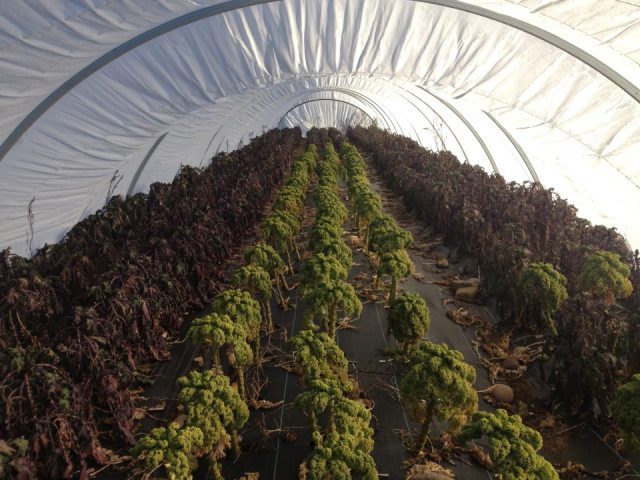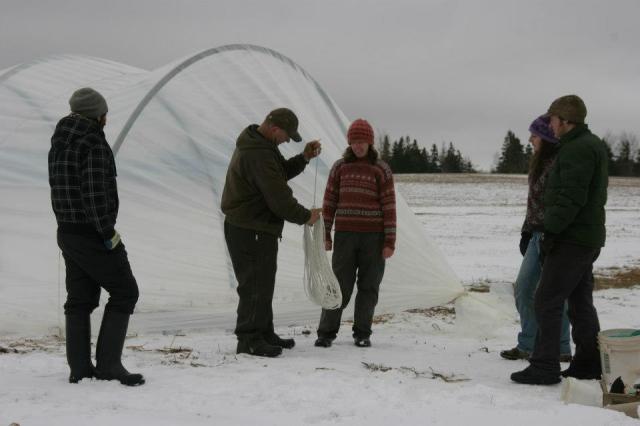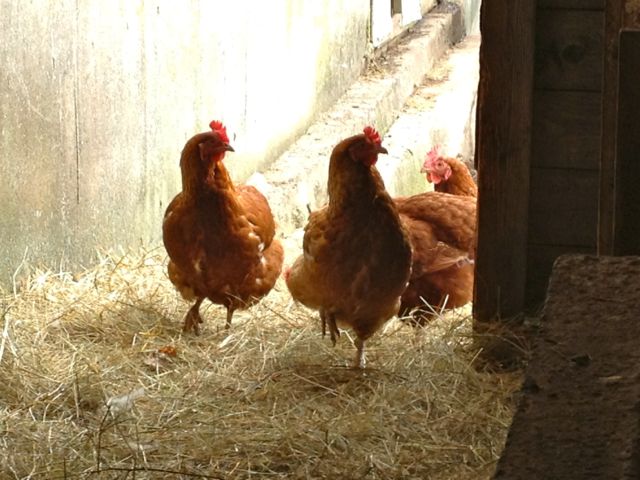Raymond Loo took some time out of his busy schedule to explain to David Greenberg how to start a potato breeding program. This is a fairly technical post, with no photos. Any farmer interested in starting a potato breeding program might be very interested in this discussion. Please get in touch (in the winter) if you are interested in working together.
Raymond: Now some varieties are way, way, way easier to work with. Island Sunset set seed like crazy so I think that’s one that a person should start with, to do a cross with. There’s some stuff like Shepody that doesn’t set any seed, or a Russet–Burbank. There’s no seed in it. They’re all sterile so you’ll see balls but they’re all sterile. There are no seeds in them. So with some varieties there is no point.
Raymond: It takes quite a while you know like the first year you’re probably not going to get any blossoms, usually, you get just a few tubers. Second year, if you’re starting with a really small potato, quite often they don’t really bloom either, the blight comes in early enough that you don’t really get any seed from them, if you do them in a greenhouse. The other way is to do some, you know it just depends on the budget and the time and who’s going to do it but if you grew some under a floating row cover, we’ve done that before- the problem with that is controlling weeds so you’ll probably have to take it off but you can increase your temperature quite a little bit and you can bring your potato along quite a bit faster. The problem is when you take the floating cover off in a place like mine that’s so bloody windy, if you’ve been growing that potato really aggressively…
David: … just to see if I understand… so you start off with seed material, let’s just say if we were doing this work, we would start it really early, plant it out, maybe get it under row cover, try to get some plants going, let’s say we get some pretty good-sized tubers, and let’s say then that we would send you tubers that you could plant out in year two that would be ready to make a seed ball potentially…
Raymond: I think what I would suggest is the second year, so the second year, we’ll say, when we’ve planted the little tubers and grown them up, at that point I would probably keep, you’d number each bag and track them, in the first year, depending on how pedigree you want to be about it you should track them right from the seed but…
David: Sounds like an awful amount of work…
Raymond: Yeah that’s a lot of work because you’re going to throw away 90% of them … Anyway but when you do save them in a little bag you have to keep track of them. What I would suggest then is that if I got ten potatoes I’d keep two of them, I’d send you eight and you’d send them out to the other[farmers]…so then you’ve four different places with two different potatoes and we all have the same number on them. And then I grow them and I see how they perform- you might have them full of scab, I might have no scab, so then we have to sit back and say, is that site-specific or is it variety-specific and so on…I would see in November, [we could] compare all the results from all of them that we’ve had growing together.
Raymond: In the third year then, I’d plant my two potatoes and at that point then I’ve got twenty potatoes- each one produces ten- and so we got together in November and said this one’s good, this one’s not, so we’ve gone from a hundred to ten, then I’m going to plant them the next year and we’ve got enough of them at that point because we’ve got four different spots to try eating some of them maybe and see how they perform again, but I should be starting a few more tubers if we’re going to perpetuate the thing, so every year you have to start a few seeds, brand new ones, every year you start- I have my ten different varieties or whatever it is that I’m growing- and then by the time that you’ve gone five years down the road, you hand them out to someone else who’s a bigger grower or whatever, we’ll probably have other people that are interested in what’s going on and say can you grow a quarter of an acre of these guys and see if they’re going to take off at the farmer’s (market?) and maybe I could do it or you…
David: And it’s not about being exclusive and small at that stage it’s just so you don’t have meetings with fifty people all going on and on and on you just have a small active group.
Raymond: Yeah I think four or five people is enough…
Raymond: So you do your hand cross and you’ve got one seed ball that comes off from that, there’s two hundred seed that comes off that ball, probably, but you do exactly the same thing next year and get two hundred again they’re not going to be the same two hundred seeds right so it’s kind of a lottery that goes on and on so we might do it the first year and see well that didn’t really produce anything that great but the next year you’ve got something that’s way better. Even if you self pollinate a potato it’s going to have two hundred different seeds.
When you take [Island] Sunshine and you take the seeds from it, just by itself, you get a whole bunch of stuff that doesn’t look anything at all like Sunshine.
David: So I think we’re getting pretty close though. We start the seed, get the second-year seed. Start the true seed, get to the point where we have second-year tubers, send those out to everyone, people grow them in third year, get them to the fall, we compare notes, exchange, keep comparing, keep exchanging, keep on making new true seed crosses.
Raymond: Yes, so after five years or so you would just be able to select them.
David: So where does the greenhouse [come into play?] except for starting the seed
Raymond: To speed things up you could graft [the potatoes] on tomatoes, the problem with that is you have to have grow lights and all that sort of stuff- we don’t really have enough light here.
David: That’s what I’m interested in doing, I mean the part with starting the seed, of course, do that centrally and that’s fine but then you have something that looks good in year two and you want to get more of it
Raymond: You want to get some seeds, so the problem is you’ve got some that look really good and it seems like they have good blight resistance. Then you want to get it to bloom so you can get a seed ball off of it, even if it’s self-pollinating you’re still going to get something that’s got a better chance of being like its parent.
If you had two that were showing really good promise then you cross them probably you’re going to get them going and then you graft that and once you get the seed, then you graft that onto a tomato and you grow it out but the problem is that you need to have, here, you’d need to have a heated greenhouse (with high-pressure sodium lights) and yes, that’s going to cost some money.
David: Let’s say in the fall you have two varieties that look good and you want to either cross them or increase them or something…you take that, you sprout it in the fall, you take off the shoot, you graft it onto a tomato that’s growing under lights with hydroponics, they’ll take off, there’ll be lots of seed, over the winter even, and so the next spring instead of a whole year being lost you have true seed to plant.
Raymond: You have to get it early enough that you can put your seed in dormancy for a short period of time because that’s one problem with potato seed, they need to go dormant for a little while (for like two weeks or something?) yeah well for a little while at least you can chill them for a little while and try to really shock them. The confounding thing is that the potato seed usually germinates better the second year rather than the first year so when we save the seed balls next spring you…we’ve had things ten, twelve, fourteen years old that are still germinating fine. So you have to have that time, otherwise- I tried one time, I’d saved all this seed and I tried to get them growing and none of the bloody things wouldn’t germinate, the odd one would but most of them wouldn’t, I just didn’t give them enough time.
David: So that’s kind of the idea if you had something that looked really good and you wanted to expand it you could grow it over the winter and then just take cuttings in the spring and plant those all out
Raymond: Yeah I mean I’ve grown sprouts…so when I had potatoes that I only had a few of and I’d had a lot of trouble with them so I would save every sprout carefully in the tray, plant the potatoes, (can’t let the sun dry them out), and then plant the sprouts and most of them will grow and then you have to watch them, closer than the potatoes.
David: That’s something we could do in the greenhouse, have a heating table
Raymond: It’ll increase exponentially from what you’d get from one or two potatoes.
David: And that could be useful…
Raymond: Yeah , yeah if you’ve got one or two that look promising- if you had blight, heavy, heavy blight and only two survived and everything else is dead but you only have those two potatoes and they taste good and look good and then you can really increase your, your…so instead of having these two potatoes and you cut these potatoes really carefully, you sprout them first and you get ten sprouts…
David: If you sprout them in December and moved those sprouts into a bigger container and take the cuttings off the sprout you could end up with two hundred plants…
Raymond: Yeah you could even do it with a little bit of tissue culture basically.
David: So that’s the basic idea, it’s safe to assume that we’d learn more tricks as we go but that’s enough of an accurate explanation of it if we’re explaining it for why we need a greenhouse, and it really is important that we have that greenhouse.
Raymond: Yeah it is and, otherwise, that would be my downfall- I would have a hard time in April and May when I’m trying to get everything ready to go to have enough time to start enough potato seeds to make a difference, like that’s the problem. I could start a hundred seeds but the chances of getting something good out of a hundred seeds is pretty small. You want to start 1,000 seeds or 2,000 seeds or 10,000. It’s like the lottery…
David: The more tickets you buy, the better your chance to win…
Raymond: The way I used to start my potatoes is starting them in the peat trays the same way as you do with lettuce and separate them back out of it. One of the problems with growing potatoes in a [seedling tray]…you can get them out but sometimes they’re too weak to pull the whole plug out.
David: Okay, we also do soil blocks, that might be really good, too. We have a 20-blocker, so we can do a lot…























































